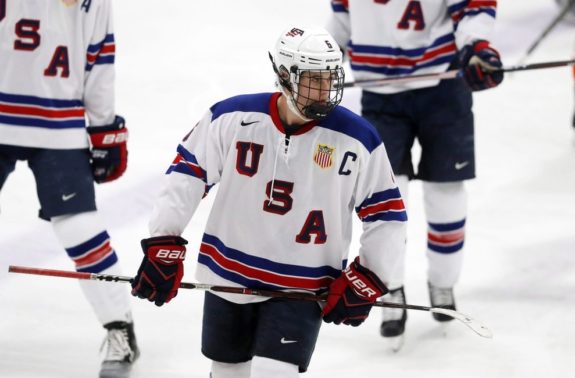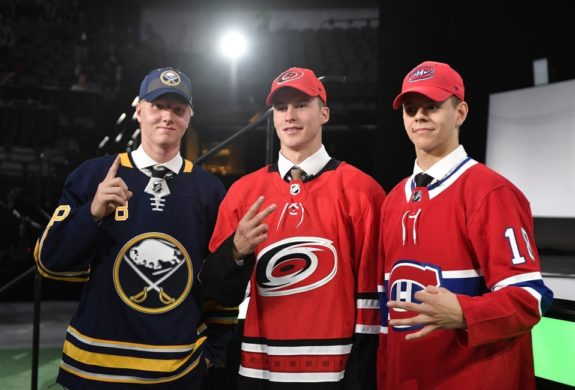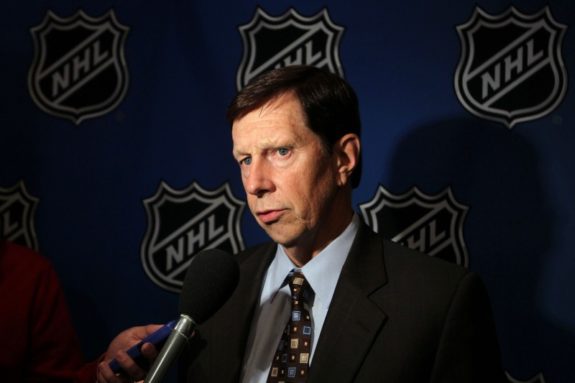The history of the NHL Entry Draft has shown that selecting players outside of the early rounds is a crap shoot, guesswork at best, or just plain luck. A study, conducted by Peter Tingling, has shown that the draft success rate (measured by a player competing in 160 games or more in the NHL which qualifies them for the league pension) between 1981-2003 dropped from 64.1 percent for players selected in the first round to 28.6 percent for second-round players. The draft success rate for fourth-round picks plummets to 14.9 percent and remains in the 9-12 percent range from the fifth to the eighth rounds (now reduced to seven rounds), (from ‘Educated Guesswork: Drafting in the National Hockey League’, – Handbook of Statistical Methods and Analyses in Sports – 2016).

Given the significantly low draft success rates after the third round, teams must make critical decisions with what is usually their first three picks of the draft (assuming they have not traded away or traded for additional picks). A crucial part of the decision-making process is whether the hockey operations staff will base their selections on organizational need or the best available player. Schellenberg suggests, “It is one of the big debates in scouting and a topic which can lead to heated discussions. Should you draft for the best available player or draft for need.”
Draft ‘For Need’ vs. ‘Best Available Player’
The draft ‘for need’ philosophy suggests there are certain holes a team needs to fill, for example, goaltending. Therefore, management may decide to select a goaltender in the first round even though the highest ranked goaltender in the draft may be ranked 40th overall. To draft the ‘best available player’ supports picking the player who the scouting staff thinks is the most talented player available when the team is called to select, regardless of the player’s position or the team’s needs.

The ‘best available player’ strategy is often dependent upon on the consensus rankings of the NHL Central Scouting Services (CSS) especially for the first two rounds where 62 total players are selected. Scouting staffs spend countless hours in arenas, studying prospect videos, and interviewing coaches, managers, and the players themselves to form their opinions about the capabilities of individual players and their future potential. Their findings may lead them to conclude that CSS individual player rankings are reasonably accurate or that the consensus is grossly mistaken.
Picking future NHL players among teenagers has been compared at times to identifying Nobel prize winners among junior high school chemistry students. (Tingling)
Opinions and Arguments
The popular opinion among NHL executives regarding this controversy appears to be that drafting the best available player is the most prudent strategy. The main reason, is the rate of change in the league, which makes short term planning very difficult for individual teams. Schellenberg points to the fact that this is true for all professional sports:
“The world of sports, in general, is a fast-moving industry. The NHL and its organizations are no exception to this. If your team is lacking depth at a specific position, of course, you should do everything possible to correct this. Therefore, it would make sense to evaluate your depth chart to identify your needs and draft for those positions. But the fact is that your needs change yearly, monthly, even daily! You never know what lucrative trade offer reaches you. You have no control over injuries, retirements or decisions to move to another league.”

However, many hockey industry experts would argue that it is difficult to select the best available player, usually at the age of 18 when their development and maturity is questionable. Wagner believes that the “…best player available is a fiction. Teams at the draft really have no idea who the best player will be when they pick. They’re taking an educated guess based on their scouts, statistics, and overall draft philosophy. It’s why we constantly see articles redrafting the first round of every draft. When the Canucks picked Cody Hodgson in 2008, he was the best player available, but he wasn’t actually the best player available. That turned out to be Erik Karlsson.”
Tingling would agree. He believes that “…picking future NHL players among teenagers has been compared at times to identifying Nobel prize winners among junior high school chemistry students.” He describes sports drafts as a ‘zero-sum game’ because players selected by one team are unable to be chosen by another organization, with all teams drawing from a dwindling supply of players. In the case of the NHL, that total currently stands at 217 players selected over seven rounds.
Related: 2019 NHL Draft Guide
The restrictions placed on NHL teams with the salary cap puts more pressure on hockey operations staff to make intelligent decisions at the draft table. Escalating salaries for star players within a salary cap system and restrictions on entry-level salaries for younger players put considerable pressure on teams to choose players at the draft that can play in the NHL within two years of their draft year. According to Tingling, “Teams need the contractually limited compensation paid to rookies to offset the higher salaries paid to franchise players.”
General Manager for Two Days
As an armchair NHL general manager, I would place myself in the ‘best available player’ camp. Change is constant in the NHL, so a team’s needs in both the short and long term are difficult to predict. Your organizational needs are always on the move. Needing a defender at the draft doesn’t mean that you will have space in your depth chart for him three years later – it might be that you traded for several defenders in the meanwhile to fill the gap.

Drafting the best available player adds to an organization’s player talent pool. The draft is an opportunity to increase a team’s resources, therefore providing more flexibility when assets are needed for trades to acquire more talented, proven players. Schellenberg would agree with that strategy. “Drafting the best player available gives you the best bargaining position for potential future deals. It gives you the opportunity to go into trade negotiations with confidence – an excess of certain player positions allows you to convert them into your needs.”
As the draft progresses past the first three rounds during day two, I would consider shifting my strategy to a player needs focus. As you get further from the first round, the ‘best available player’ strategy becomes even more relative. The apparent difference in player skill and talent in the later rounds is difficult to assess. My overall strategy would be to avoid being unlucky when choosing talent in the first three rounds and hope to be lucky in rounds four to seven.